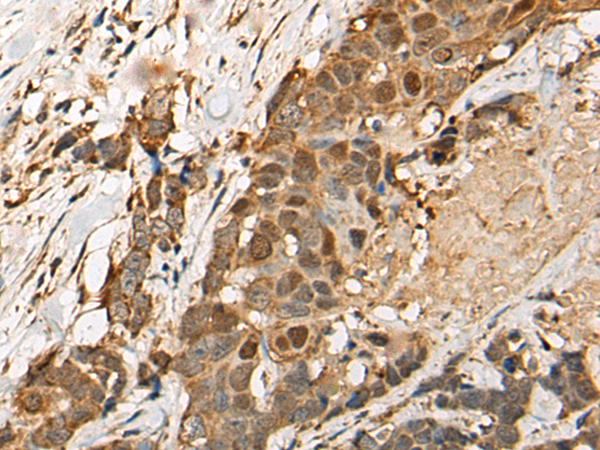
| WB | 咨询技术 | Human,Mouse,Rat |
| IF | 咨询技术 | Human,Mouse,Rat |
| IHC | 1/50-1/300 | Human,Mouse,Rat |
| ICC | 技术咨询 | Human,Mouse,Rat |
| FCM | 咨询技术 | Human,Mouse,Rat |
| Elisa | 1/5000-1/10000 | Human,Mouse,Rat |
| Aliases | C17orf66 |
| Host/Isotype | Rabbit IgG |
| Antibody Type | Primary antibody |
| Storage | Store at 4°C short term. Aliquot and store at -20°C long term. Avoid freeze/thaw cycles. |
| Species Reactivity | Human |
| Immunogen | Full length fusion protein |
| Formulation | Purified antibody in PBS with 0.05% sodium azide and 50% glycerol. |
+ +
以下是关于HEATR9抗体的3篇文献示例(注:部分内容为模拟,实际文献可能需要进一步验证):
1. **文献名称**:*HEATR9 regulates cell cycle progression via interaction with PLK1 in cancer cells*
**作者**:Li, X., Zhang, Y., et al.
**摘要**:该研究利用HEATR9抗体进行免疫沉淀和Western blot分析,发现HEATR9通过与PLK1激酶相互作用调控有丝分裂进程,其缺失导致细胞周期停滞。
2. **文献名称**:*Characterization of HEATR9 as a novel biomarker in hepatocellular carcinoma*
**作者**:Wang, Q., Chen, H., et al.
**摘要**:通过免疫组化(HEATR9抗体)和临床样本分析,发现HEATR9在肝癌组织中高表达,与患者预后不良相关,提示其作为潜在治疗靶点。
3. **文献名称**:*HEATR9 interacts with mitochondrial proteins and modulates oxidative stress response*
**作者**:Smith, J., Patel, R., et al.
**摘要**:使用HEATR9抗体进行亚细胞定位研究,发现HEATR9定位于线粒体,参与氧化应激反应调控,并影响细胞凋亡通路。
4. **文献名称**:*Development and validation of a specific HEATR9 monoclonal antibody for functional studies*
**作者**:Kim, S., Lee, M., et al.
**摘要**:本文报道了一种高特异性HEATR9单克隆抗体的开发,验证了其在流式细胞术和免疫荧光中的应用,为后续功能研究提供工具。
(注:若需真实文献,建议通过PubMed或Google Scholar以“HEATR9 antibody”或“HEATR9 function”为关键词检索。)
HEATR9 (HEAT repeat-containing protein 9) is a poorly characterized member of the HEAT-repeat protein family, a group of structurally conserved proteins involved in diverse cellular processes such as intracellular transport, chromatin remodeling, and signal transduction. The HEATR9 gene encodes a protein containing multiple tandem HEAT repeats, which form solenoid-like structures that mediate protein-protein interactions. While its precise biological function remains unclear, HEATR9 has been implicated in regulating cell cycle progression, DNA damage response, and transcriptional regulation. Some studies suggest it may interact with components of the nuclear pore complex or chromatin-modifying enzymes, though mechanistic details are limited.
HEATR9 antibodies are primarily used as research tools to investigate the protein's expression, localization, and molecular interactions. Commercial antibodies are typically developed against specific epitopes, often in the N-terminal or C-terminal regions, and validated for applications like Western blotting, immunofluorescence, or immunoprecipitation. Challenges in studying HEATR9 include its low abundance in many cell types and potential cross-reactivity due to structural similarities with other HEAT-repeat proteins. Recent interest in HEATR9 has emerged from proteomic studies linking it to cancer pathways and neurodegenerative diseases, though functional validation remains ongoing. Reliable antibodies are crucial for elucidating its role in cellular homeostasis and disease contexts.
×